Development of Operating Strategies for Return Fan in HVAC System Considering Differential Pressure
Abstract
:1. Introduction
- It analyzes the issues caused by the lack of consideration for pressure differences in traditional HVAC operation strategies and proposes a new operation strategy that takes pressure differences into account.
- The strategy controls the return fan, rather than the supply fan, to satisfy the requirements for the indoor thermal environment while simultaneously controlling the pressure difference.
2. Methodology
2.1. Pressure Control Using Return Fans
2.2. Relationship Between Airflow and Pressure Difference
3. Return Fan Operation Strategy Considering Pressure Difference
4. Case Study
4.1. Overview of Target Building and System
4.2. Existing Return Fan Operating Strategy
4.3. Proposed Return Fan Operating Strategy for HVAC System
5. Results and Discussion
6. Conclusions
- (1)
- The proposed method uses the return fan to maintain positive pressure in the building by adjusting the return airflow according to the supply airflow and infiltration amount due to external conditions. The average pressure differential of the four building facades was used as the basis, considering wind pressure and stack effect.
- (2)
- An office building with a variable air volume (VAV) system was selected for evaluation. Using TRNSYS’s Simulation Studio and TRNFLOW, the traditional operation method (Case 1) and the proposed method (Case 2) were compared and analyzed. Both methods met the indoor set temperature target of 24 °C. In terms of pressure differential and infiltration amount, the maximum indoor–outdoor pressure differential was 142 Pa for Case 1 and 18 Pa for Case 2, an 84% reduction. The average infiltration amount was 6744 CMH for Case 1 and 113 CMH for Case 2, a 98% reduction. In terms of energy consumption, the return fan energy consumption decreased by 62%, and reheat coil energy consumption decreased by 61% due to reduced infiltration. The total HVAC system energy consumption was reduced by approximately 29% compared to Case 1.
- (1)
- While the proposed method aims to maintain positive pressure to minimize energy consumption, it has limitations in adjusting airflow solely through the return fan. Future research should explore methods for simultaneously controlling supply and return airflow based on pressure differentials to maintain positive pressure and achieve further energy savings while satisfying requirements for the indoor thermal environment.
- (2)
- The proposed method, considering a single zone and external pressure differential, may be too simplistic for multi-zone buildings. Future research should address pressure control methods for VAV systems in multi-zone buildings.
Author Contributions
Funding
Data Availability Statement
Conflicts of Interest
Abbreviations
| Total Differential Pressure, Pa | |
| Differential Pressure from stack effect, Pa | |
| Differential Pressure from wind, Pa | |
| Differential Pressure from ventilation, Pa | |
| Airflow through opening, | |
| Differential Pressure across building envelope, Pa | |
| Flow Coefficient, | |
| Pressure Exponent, - | |
| HVAC system supply airflow, | |
| HVAC system return airflow, | |
| Local exhaust airflow, | |
| Outdoor infiltration airflow, | |
| Indoor exfiltration airflow, |
References
- United Nations Environment Programme (UNEP). 2020 Global Status Report for Buildings and Construction: Towards a Zero-Emission, Efficient and Resilient Buildings and Construction Sector; United Nations Environment Programme: Nairobi, Kenya, 2020. [Google Scholar]
- Gholipour, H.F.; Arjomandi, A.; Yam, S. Green property finance and CO2 emissions in the building industry. Glob. Financ. J. 2022, 51, 100696. [Google Scholar] [CrossRef]
- US Department of Energy. Commercial Buildings Energy Consumption Survey; US Department of Energy: Washington, DC, USA, 2018. [Google Scholar]
- McIntosh, R. Savings with variable speed control. Energy Eng. 2014, 111, 7–31. [Google Scholar] [CrossRef]
- Okochi, G.S.; Yao, Y. A review of recent developments and technological advancements of variable-air-volume (VAV) air-conditioning systems. Renew. Sustain. Energy Rev. 2016, 59, 784–817. [Google Scholar] [CrossRef]
- American Society of Heating, Refrigerating and Air-Conditioning Engineers (ASHRAE). Design and Application of Controls. In ASHRAE Handbook Application; Chapter 47; ASHRAE: Peachtree Corners, GA, USA, 2020. [Google Scholar]
- Guyot, G.; Schild, P.G.; Carrié, R. Stimulation of Good Building and Ductwork Airtightness Through EPBD; Air Infiltration and Ventilation Centre: Flanders, Belgium, 2010. [Google Scholar]
- Park, S.; Park, S.; Song, D. Applicability and evaluation of airtightness prediction method using pressure differences under actual climate conditions. J. Build. Eng. 2023, 78, 107628. [Google Scholar] [CrossRef]
- Phalak, K.; Wang, G. Minimum outdoor air control and building pressurization with lack of airflow and pressure sensors in air-handling units. J. Archit. Eng. 2016, 22, 04015017. [Google Scholar] [CrossRef]
- Zheng, B.; Pang, X.; Liu, M.; Joo, I. Using a Fan Air Flow Station to Control Building Static Pressure in a Variable Volume Air Conditioning System. In Proceedings of the International Solar Energy Conference, Orlando, FL, USA, 6–12 August 2005; Volume 47373, pp. 581–587. [Google Scholar]
- Liu, M. Variable speed drive volumetric tracking for airflow control in variable air volume systems. J. Sol. Energy Eng. 2003, 125, 318–323. [Google Scholar] [CrossRef]
- Mumma, S.A. Dedicated outdoor air systems and building pressurization. Am. Soc. Heat. Refrig. Air-Cond. Eng. Trans. 2010, 116, 143. [Google Scholar]
- Coogan, J. Control of space pressurization for sealed or tight rooms. Am. Soc. Heat. Refrig. Air-Cond. Eng. Trans. 2012, 118, 450–458. [Google Scholar]
- Guo, J.; Liu, J.; Tu, D.; Zhang, J.; Xu, J.; Xue, P. Multizone modeling of pressure difference control analyses for an infectious disease hospital. Build. Environ. 2021, 206, 108341. [Google Scholar] [CrossRef]
- Wang, G.; Phalak, K. Reverse Relief Airflow Prevention and Building Pressurization with a Decoupled Relief Air Damper in Air Handling Units. Am. Soc. Heat. Refrig. Air-Cond. Eng. Trans. 2016, 122, 354–366. [Google Scholar]
- Shi, S.; Miyata, S.; Akashi, Y.; Momota, M.; Sawachi, T.; Gao, Y. Model-based optimal control strategy for multizone VAV air-conditioning systems for neutralizing room pressure and minimizing fan energy consumption. Build. Environ. 2024, 256, 111464. [Google Scholar] [CrossRef]
- Yang, S.; Wan, M.P.; Chen, W.; Ng, B.F.; Zhai, D. An adaptive robust model predictive control for indoor climate optimization and uncertainties handling in buildings. Build. Environ. 2019, 163, 106326. [Google Scholar] [CrossRef]
- Berge, A. Analysis of Methods to Calculate Air Infiltration for Use in Energy Calculations. Master’s Thesis, Chalmers University of Technology, Göteborg, Sweden, 2011. [Google Scholar]
- American Society of Heating, Refrigerating and Air-Conditioning Engineers (ASHRAE). Ventilation and Infiltration. In ASHRAE Handbook Fundamentals; Chapter 16; ASHRAE: Peachtree Corners, GA, USA, 2021. [Google Scholar]
- Spitler, J.D. Load Calculation Applications Manual, 2nd ed.; American Society of Heating, Refrigerating and Air-Conditioning Engineers: Atlanta, GA, USA, 2014. [Google Scholar]
- Yu, J.Y.; Song, K.D.; Cho, D.W. Resolving stack effect problems in a high-rise office building by mechanical pressurization. Sustainability 2017, 9, 1731. [Google Scholar] [CrossRef]
- The Society of Air-Conditioning ad Refrigerating Engineers of Korea. Engineering Equipment Manual; The Society of Air-conditioning ad Refrigerating Engineers of Korea: Seoul, Republic of Korea, 2011; Volume 2. [Google Scholar]
- ISO 7730-2005; Ergonomics of the Thermal Environment-Analytical Determination and Interpretation of Thermal Comfort Using Calculation of the PMV and PPD Indices and Local Thermal Comfort Criteria. International Organization for Standardization: Geneva, Switzerland, 2005.
- Trane. Commercial Building Pressurization. Trane Eng. Newsl. 2002, 31, 2. [Google Scholar]


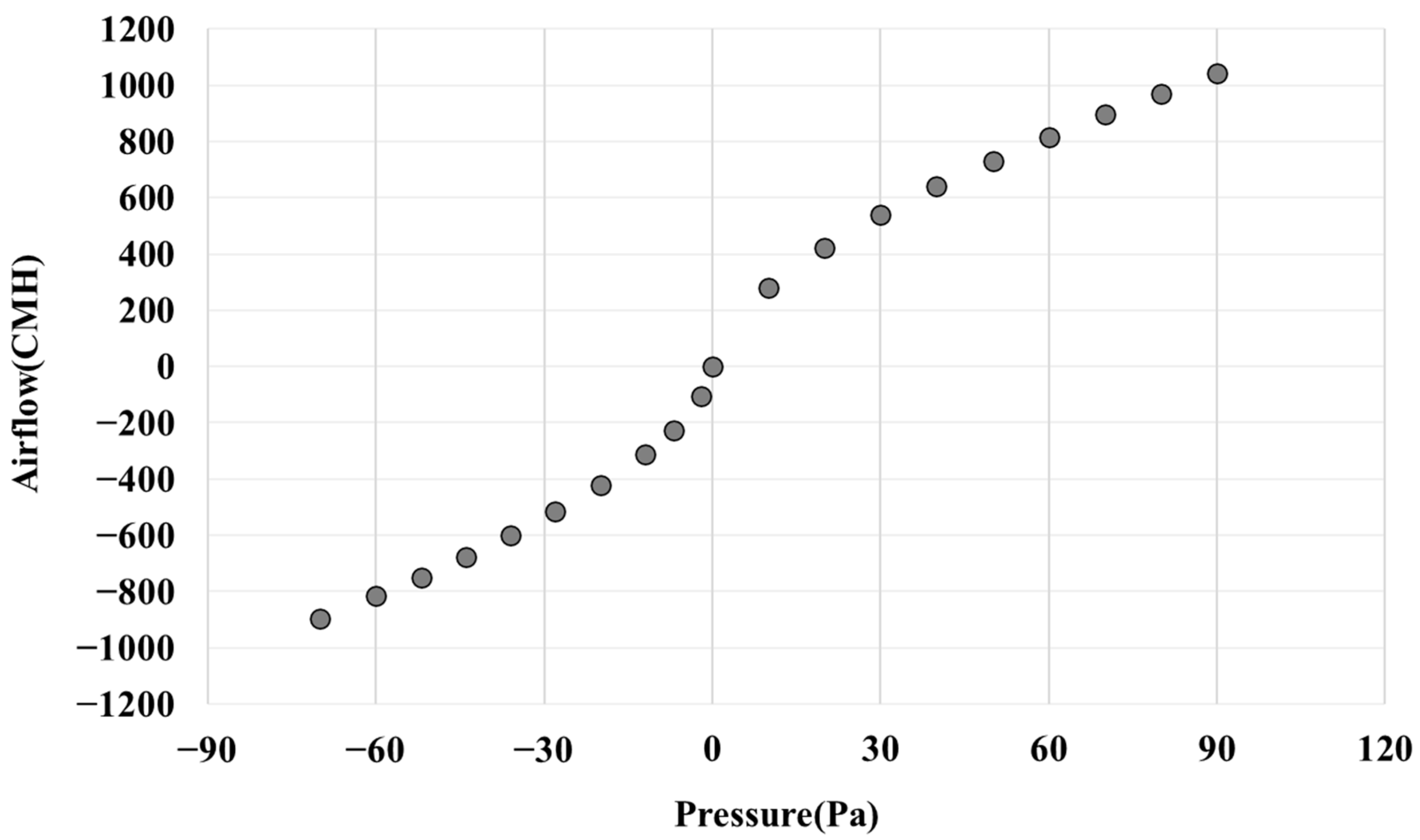

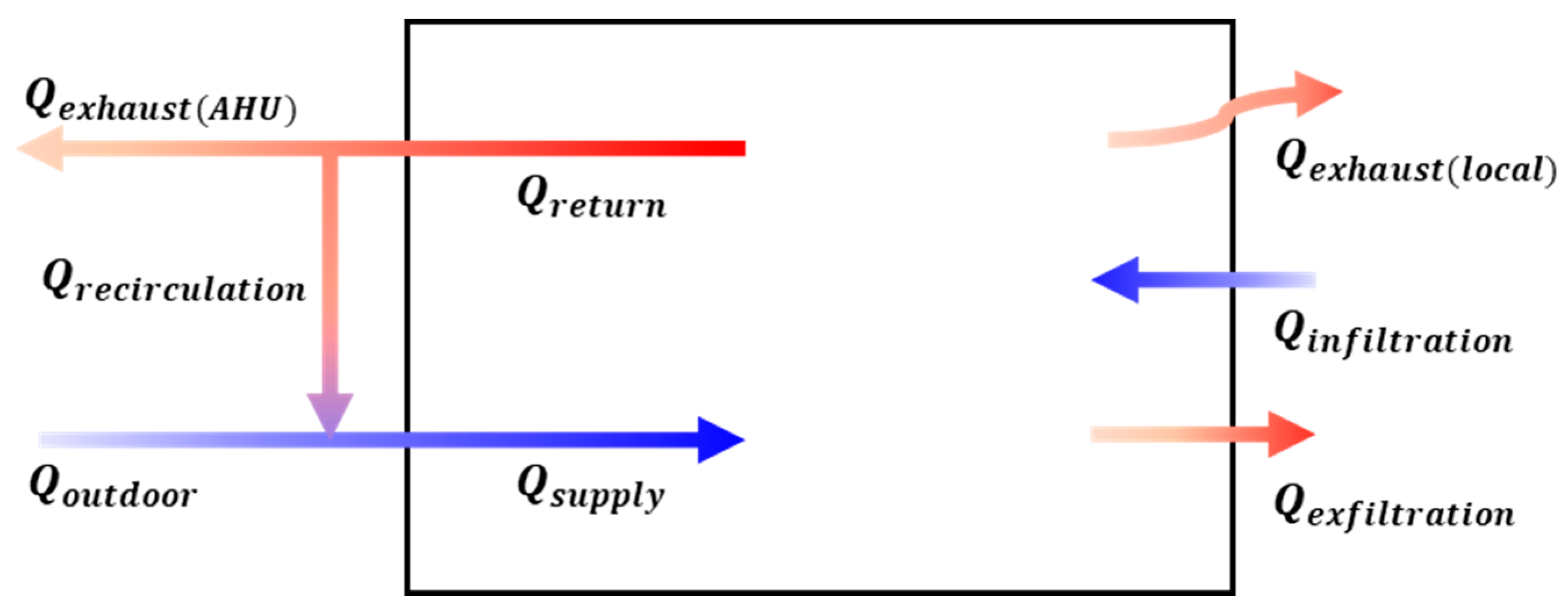





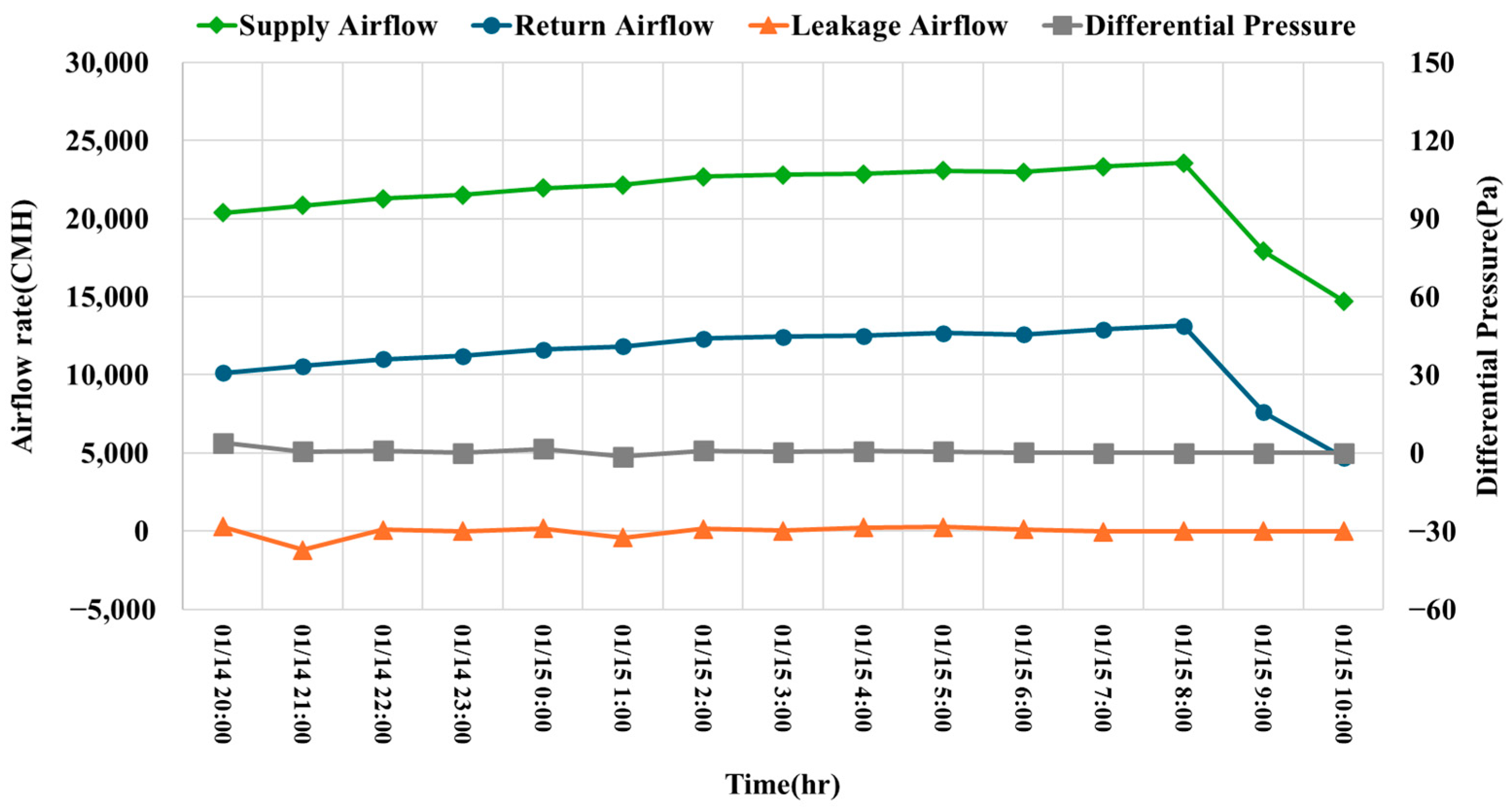

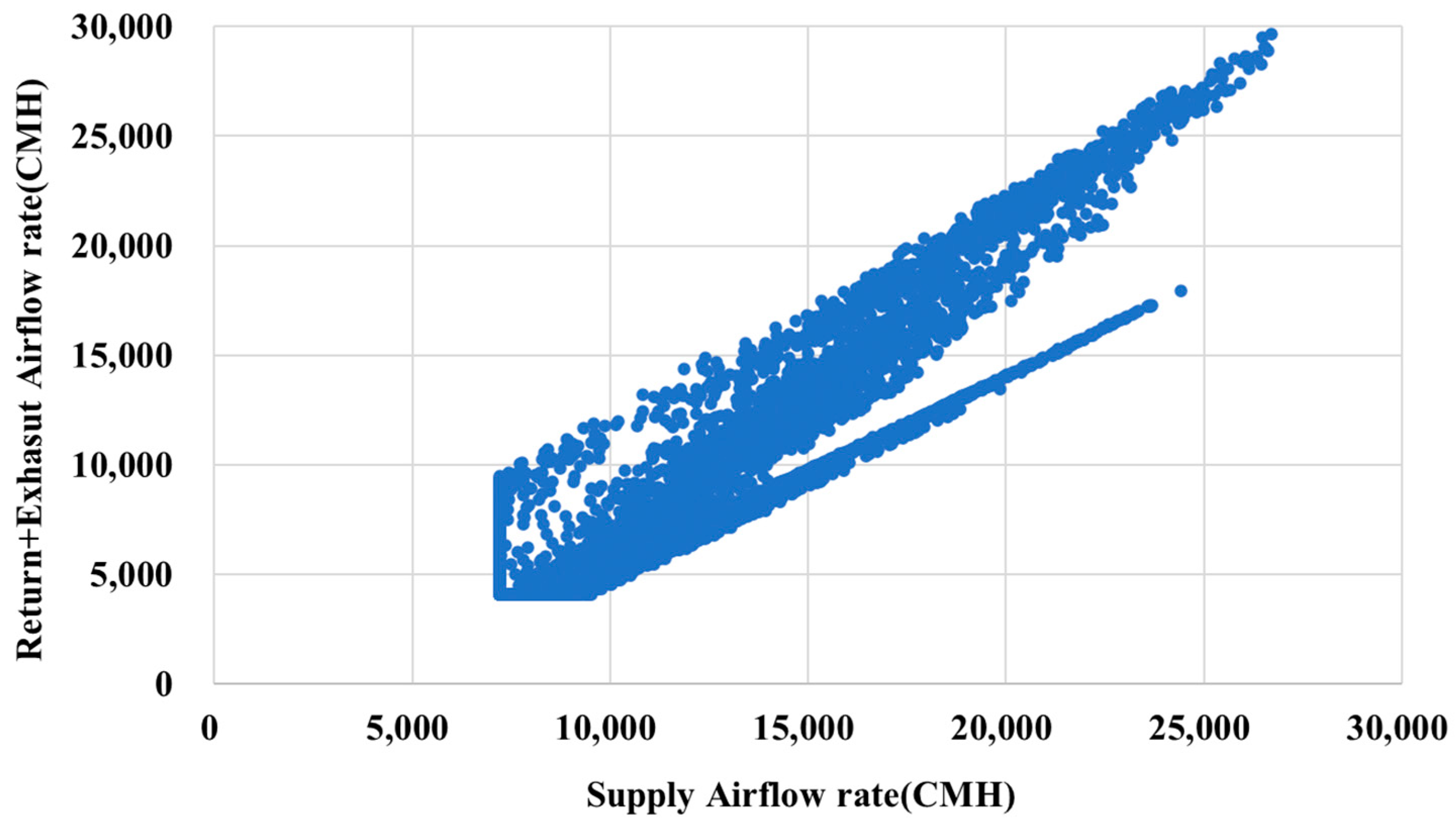
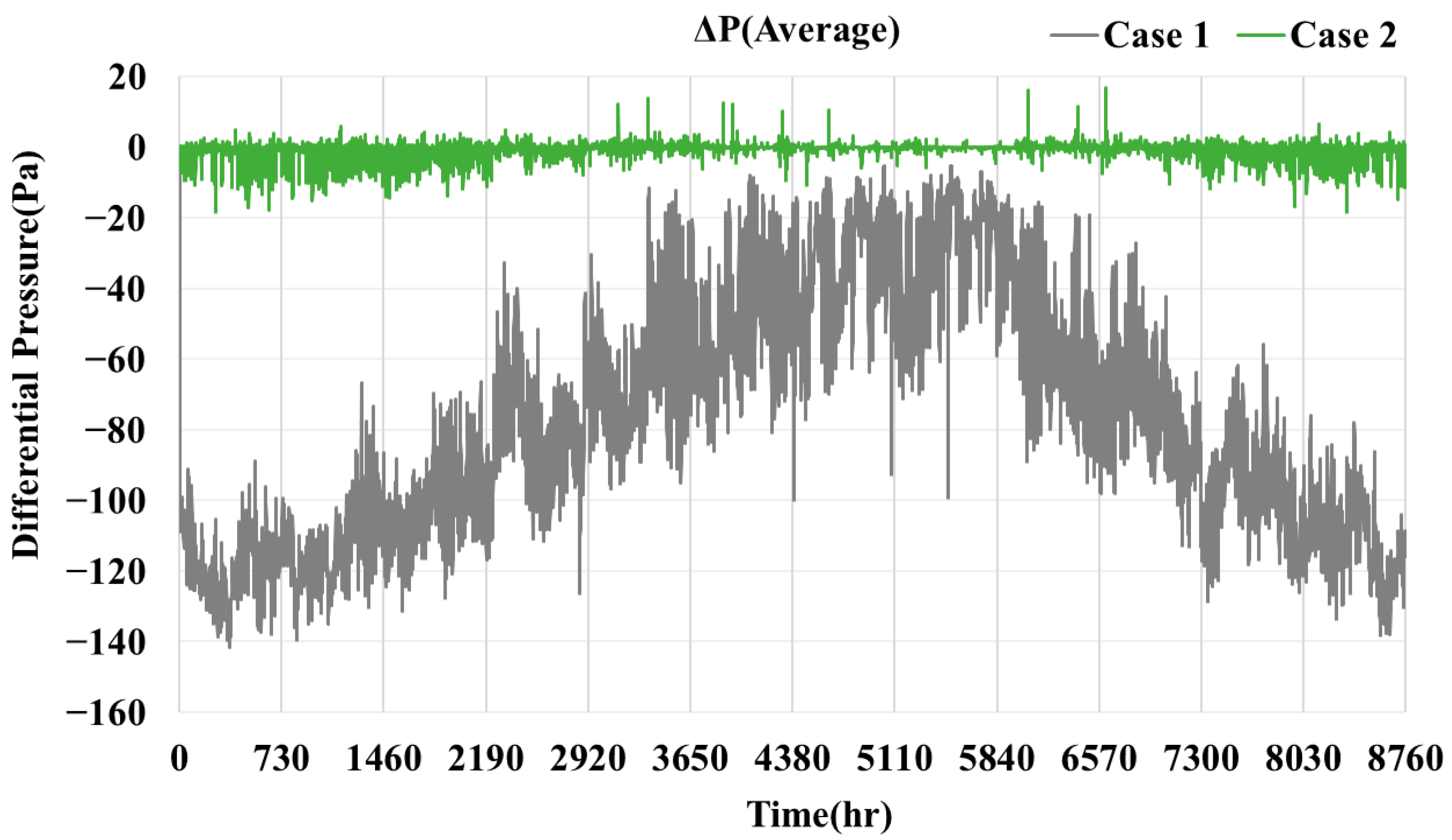


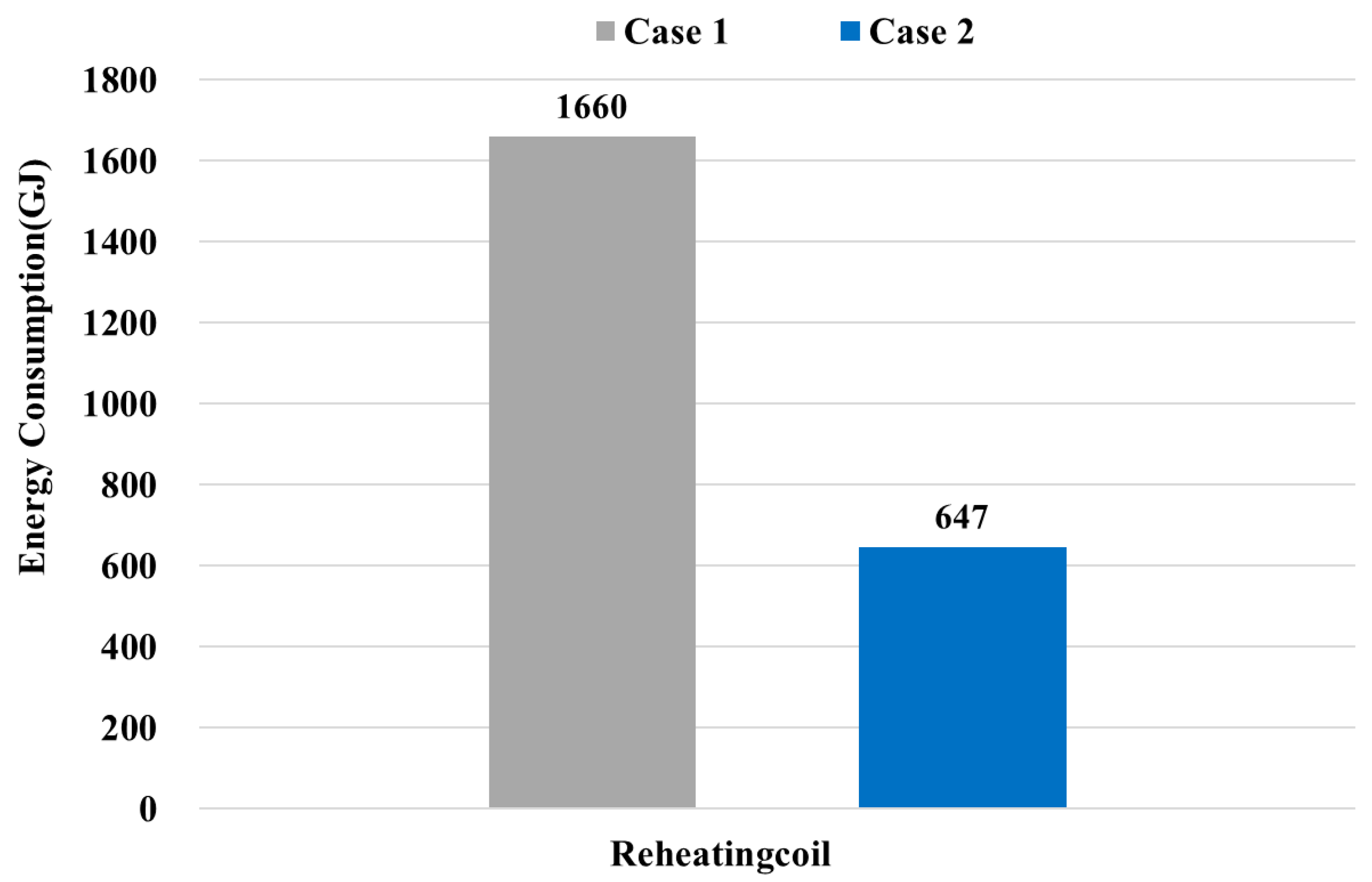
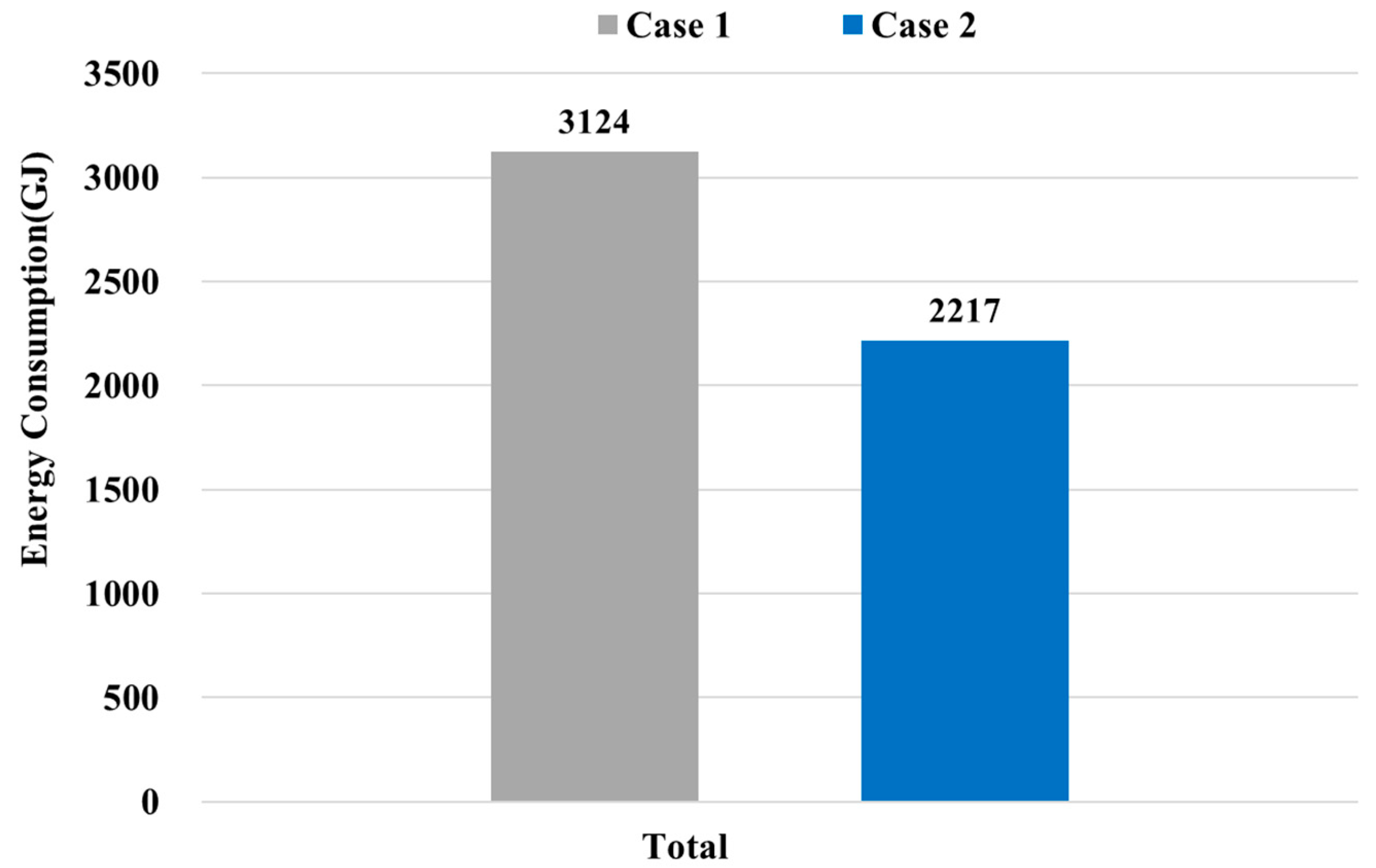
| Lists | Contents | ||||
|---|---|---|---|---|---|
| Buildings | Location | Seoul, Republic of Korea | |||
| Use | Office | ||||
| Systems | VAV terminal unit | VAV terminal unit with reheat system | |||
| Air Handling Unit (AHU) | Supply fan | Design airflow | 34,400 CMH | ||
| Design static pressure | 1065 Pa | ||||
| Design power | 5.5·4 kW | ||||
| Return fan | Design airflow | 34,400 CMH | |||
| Design static pressure | 1065 Pa | ||||
| Design power | 5.5·4 kW | ||||
| Exhaust fan | Design airflow | 4100 CMH | |||
| Operation condition | Schedule | 24 h | |||
| Set point temperature | 24 °C | ||||
| Load conditions | Occupant | Seated, light work, typing: 150 W/person | |||
| Equipment | 30 W/m2 | ||||
| Light | 15 W/m2 | ||||
| Material properties U-value | Outdoor wall | 0.310 W/m2·K | |||
| Indoor wall | 0.508 W/m2·K | ||||
| Floor | 0.09 W/m2·K | ||||
| Ceiling | 0.316 W/m2·K | ||||
| Case | Control Logic | Classification |
|---|---|---|
| Case 1 (Existing strategy) | Supply airflow tracking | Return airflow = Supply airflow |
| Case 2 (Proposed strategy) | Differential pressure tracking | Return airflow = Supply airflow − Leakage airflow |
Disclaimer/Publisher’s Note: The statements, opinions and data contained in all publications are solely those of the individual author(s) and contributor(s) and not of MDPI and/or the editor(s). MDPI and/or the editor(s) disclaim responsibility for any injury to people or property resulting from any ideas, methods, instructions or products referred to in the content. |
© 2024 by the authors. Licensee MDPI, Basel, Switzerland. This article is an open access article distributed under the terms and conditions of the Creative Commons Attribution (CC BY) license (https://creativecommons.org/licenses/by/4.0/).
Share and Cite
Lee, H.-I.; Kim, H.-J.; Lee, J.-H.; Cho, Y.-H. Development of Operating Strategies for Return Fan in HVAC System Considering Differential Pressure. Energies 2024, 17, 5289. https://doi.org/10.3390/en17215289
Lee H-I, Kim H-J, Lee J-H, Cho Y-H. Development of Operating Strategies for Return Fan in HVAC System Considering Differential Pressure. Energies. 2024; 17(21):5289. https://doi.org/10.3390/en17215289
Chicago/Turabian StyleLee, Hye-In, Hyo-Jun Kim, Jin-Hyun Lee, and Young-Hum Cho. 2024. "Development of Operating Strategies for Return Fan in HVAC System Considering Differential Pressure" Energies 17, no. 21: 5289. https://doi.org/10.3390/en17215289
APA StyleLee, H.-I., Kim, H.-J., Lee, J.-H., & Cho, Y.-H. (2024). Development of Operating Strategies for Return Fan in HVAC System Considering Differential Pressure. Energies, 17(21), 5289. https://doi.org/10.3390/en17215289






